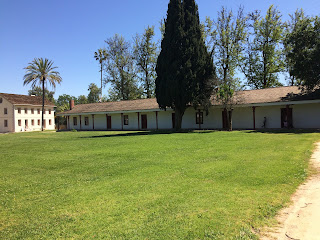There are two key areas of Southern California that actually treat their French roots with respect. The first, as I've mentioned, is the San Fernando Valley.
The second - and virtually no outsider knows this - is the tiny town of Ramona.
Situated in northeastern San Diego County, Ramona is an unincorporated town named after Helen Hunt Jackson's famous novel. (By the way, getting there can be a challenge. It's well off the beaten path, and some of the highway signage is confusing and/or missing. Do yourself a HUGE favor and take Highway 67 through Poway. The 78 SEEMS shorter and more direct, but trust me, it's not.)
The town was previously called Nuevo. But don't let the Spanish names fool you - Ramona's deepest roots are heavily French.
Like many other French families who came to Los Angeles, the Verlaque family moved farther afield in search of land. They raised sheep in San Diego, and by 1886 were making a good enough living to build themselves a little place out in the country.
This house - the Verlaque family's country retreat - was the first permanent building in the Ramona area.
It's also the only known example of a French Colonial house built out of adobe.
The town of Ramona clearly respects its French pioneers.
When Henri Penelon painted the rebuilt Old Plaza Church, he was assisted by 21-year-old Bernard Etcheverry, who had just arrived from France. As you can see, Bernard and his family eventually settled in Ramona.
I should note that the Guy B. Woodward Museum, housed in the Verlaque adobe, does NOT allow photography. I was granted special permission to photograph two items in the museum because they are original to the Verlaque family.
This soup tureen belonged to Elizabeth Verlaque and was used in this house.
To the untrained eye, this might LOOK like any fireplace you'd find in an adobe house's kitchen...
Theophile Verlaque, however, had the roasting spit custom made (in Paris!) for the house. It has a built-in mechanical timer to ensure perfectly cooked meat. What can I say? Even way back in 1886...even in a humble country retreat...we like our food cooked perfectly (and I don't even eat meat).
The Verlaques, like most French families, buried their dead in the local Catholic cemetery. However, San Diego's Calvary Cemetery was turned into Mission Hills Park (previously called Pioneer Park) in the 1970s. They took out the tombstones, but not the bodies (I wonder if Pioneer Park might have been the inspiration for Poltergeist...incidentally, San Diego has quite a long history of flagrantly disrespecting its dead). In any case, two of the Verlaque family's tombstones were salvaged (most of the tombstones were simply thrown into a ditch on the edge of the "park") and can now be found outside the house.
The Etcheverry family home exists only in memories (if I had to take a guess as to why, I'd say it might have something to do with the fact that San Diego County's backcountry is prone to brush fires). But, a few miles south of the Verlaque house, Etcheverry Street still bears the family's name.




























